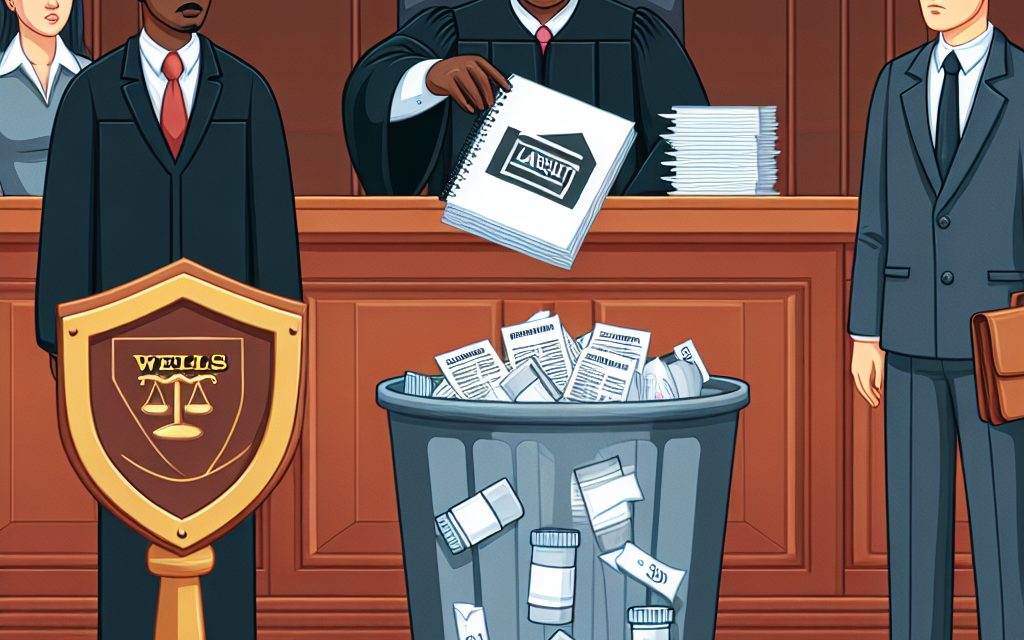Court Throws Out Lawsuit Against Wells Fargo Regarding Prescription Drug Pricing
The recent dismissal of a lawsuit against Wells Fargo concerning prescription drug pricing has sparked significant discussion in the financial and healthcare sectors. This case highlights the complexities of pharmaceutical pricing, the role of financial institutions in healthcare, and the legal frameworks that govern these interactions. In this article, we will explore the implications of this ruling, the intricacies of drug pricing, and the broader context of healthcare financing.
Understanding the Lawsuit Against Wells Fargo
The lawsuit against Wells Fargo was initiated by a group of plaintiffs who alleged that the bank had engaged in deceptive practices related to the financing of prescription drugs. The plaintiffs claimed that Wells Fargo had facilitated inflated drug prices through its financial services, thereby contributing to the rising costs of healthcare for consumers.
At the heart of the lawsuit was the assertion that Wells Fargo, as a financial institution, had a responsibility to ensure that its practices did not contribute to the exorbitant costs of prescription medications. The plaintiffs argued that the bank’s involvement in the pharmaceutical supply chain allowed it to profit from inflated prices, which ultimately harmed consumers.
However, the court found that the claims against Wells Fargo lacked sufficient legal grounding. The judge ruled that the bank’s role was primarily as a financial intermediary and did not extend to the pricing strategies employed by pharmaceutical companies. This ruling has significant implications for how financial institutions interact with the healthcare sector and raises questions about accountability in drug pricing.
The Legal Framework Surrounding Drug Pricing
The legal landscape governing drug pricing is complex and multifaceted. It involves various stakeholders, including pharmaceutical companies, healthcare providers, insurers, and financial institutions. Understanding this framework is crucial to grasping the implications of the Wells Fargo case.
- Regulatory Oversight: The pharmaceutical industry is heavily regulated by federal and state agencies, including the Food and Drug Administration (FDA) and the Centers for Medicare & Medicaid Services (CMS). These agencies set guidelines for drug approval, pricing, and reimbursement.
- Antitrust Laws: Antitrust laws are designed to prevent monopolistic practices and promote competition in the marketplace. Pharmaceutical companies must navigate these laws when setting prices for their products.
- Consumer Protection Laws: These laws aim to protect consumers from deceptive practices and ensure transparency in pricing. The plaintiffs in the Wells Fargo case relied on these laws to argue their case.
- Contractual Agreements: Financial institutions often enter into contracts with pharmaceutical companies and healthcare providers, which can influence pricing structures and reimbursement rates.
- Litigation Trends: The rise of lawsuits related to drug pricing reflects a growing concern among consumers and advocacy groups about the affordability of medications.
In the context of the Wells Fargo lawsuit, the court’s ruling underscores the importance of understanding the legal boundaries of financial institutions’ involvement in healthcare. While banks may provide financing solutions for pharmaceutical companies, their liability for pricing practices remains limited unless there is clear evidence of wrongdoing.
The Role of Financial Institutions in Healthcare
Financial institutions play a crucial role in the healthcare sector, providing essential services that facilitate the delivery of care and the availability of medications. However, their involvement also raises ethical questions about profit motives and consumer welfare.
- Financing Drug Development: Banks often provide loans and investment capital to pharmaceutical companies for research and development. This funding is critical for bringing new drugs to market but can also lead to higher prices if companies seek to recoup their investments.
- Insurance and Reimbursement: Financial institutions are involved in the insurance sector, which impacts how drugs are priced and reimbursed. Insurers negotiate prices with pharmaceutical companies, influencing the final cost to consumers.
- Healthcare Investment: Many banks have dedicated healthcare investment divisions that focus on mergers and acquisitions within the pharmaceutical industry. These transactions can lead to market consolidation, affecting competition and pricing.
- Consumer Financing Options: Some banks offer financing options for consumers to pay for medications, which can help alleviate immediate financial burdens but may also lead to long-term debt.
- Ethical Considerations: The profit-driven nature of financial institutions raises ethical questions about their role in healthcare. Critics argue that prioritizing profits can lead to practices that harm consumers.
The Wells Fargo case illustrates the delicate balance that financial institutions must strike between providing necessary services and ensuring that their practices do not contribute to the rising costs of healthcare. As the industry evolves, it will be essential for banks to navigate these challenges responsibly.
The Impact of Rising Prescription Drug Prices
The issue of rising prescription drug prices has become a focal point in healthcare discussions, affecting millions of Americans. Understanding the factors contributing to these increases is vital for grasping the broader implications of the Wells Fargo lawsuit.
- Market Dynamics: The pharmaceutical market is characterized by limited competition for many drugs, particularly those that are newly developed or have patent protections. This lack of competition allows companies to set higher prices.
- Research and Development Costs: Pharmaceutical companies often cite high R&D costs as a justification for elevated drug prices. However, critics argue that these costs are not always transparent and can be inflated.
- Insurance Coverage: The structure of insurance coverage can impact drug pricing. High deductibles and copayments can make medications unaffordable for consumers, even if they are covered by insurance.
- Government Policies: Policies at both the federal and state levels can influence drug pricing. For example, price negotiation policies and importation laws can affect how much consumers pay for medications.
- Public Sentiment: Rising drug prices have led to increased public outcry and calls for reform. Advocacy groups are pushing for greater transparency and accountability in drug pricing.
The implications of rising prescription drug prices extend beyond individual consumers; they affect the entire healthcare system. As costs continue to rise, the burden on patients and insurers increases, leading to calls for systemic change. The Wells Fargo lawsuit is just one example of how stakeholders are grappling with these challenges.
Future Implications and Industry Reactions
The dismissal of the lawsuit against Wells Fargo has significant implications for the financial and healthcare industries. It raises questions about accountability, transparency, and the future of drug pricing litigation.
- Legal Precedents: The ruling sets a precedent for future lawsuits against financial institutions involved in healthcare. It may deter similar claims unless there is clear evidence of wrongdoing.
- Increased Scrutiny: Financial institutions may face increased scrutiny from regulators and advocacy groups regarding their role in drug pricing and healthcare financing.
- Industry Collaboration: The case may prompt greater collaboration between financial institutions and healthcare providers to address rising drug prices and improve transparency.
- Consumer Advocacy: Advocacy groups are likely to continue pushing for reforms in drug pricing, which could lead to new legislation and regulatory changes.
- Market Dynamics: The ruling may influence how financial institutions approach investments in the pharmaceutical sector, potentially leading to changes in funding strategies.
As the healthcare landscape continues to evolve, the implications of the Wells Fargo case will resonate throughout the industry. Stakeholders must remain vigilant in addressing the challenges posed by rising drug prices and the role of financial institutions in this complex ecosystem.
Conclusion
The dismissal of the lawsuit against Wells Fargo regarding prescription drug pricing underscores the complexities of the healthcare financing landscape. While the court ruled that the bank’s role did not extend to pricing practices, the case highlights the need for greater accountability and transparency in the pharmaceutical industry.
As rising drug prices continue to impact consumers and the healthcare system, stakeholders must work collaboratively to address these challenges. The legal framework surrounding drug pricing, the role of financial institutions, and the implications of rising costs are all critical components of this ongoing discussion.
Ultimately, the Wells Fargo case serves as a reminder of the intricate relationships between finance and healthcare. As we move forward, it will be essential to prioritize consumer welfare and ensure that financial practices do not contribute to the growing burden of prescription drug costs.





